(完整word版)英语翻译理论与实践
- 格式:doc
- 大小:435.51 KB
- 文档页数:83
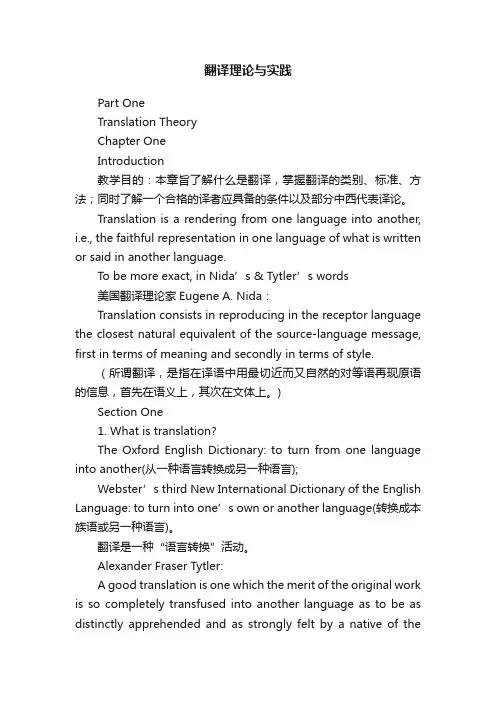
翻译理论与实践Part OneTranslation TheoryChapter OneIntroduction教学目的:本章旨了解什么是翻译,掌握翻译的类别、标准、方法;同时了解一个合格的译者应具备的条件以及部分中西代表译论。
Translation is a rendering from one language into another, i.e., the faithful representation in one language of what is written or said in another language.To be more exact, in Nida’s & Tytler’s words美国翻译理论家Eugene A. Nida:Translation consists in reproducing in the receptor language the closest natural equivalent of the source-language message, first in terms of meaning and secondly in terms of style.(所谓翻译,是指在译语中用最切近而又自然的对等语再现原语的信息,首先在语义上,其次在文体上。
)Section One1. What is translation?The Oxford English Dictionary: to turn from one language into another(从一种语言转换成另一种语言);Webster’s third New International Dictionary of the English Language: to turn into one’s own or another language(转换成本族语或另一种语言)。
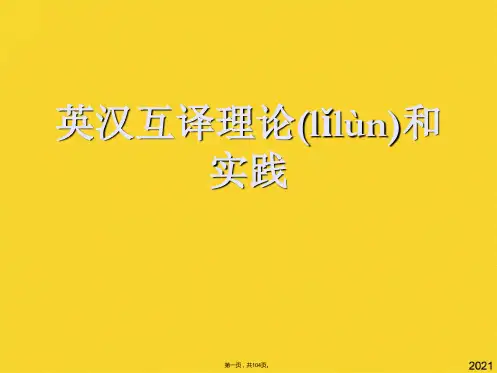
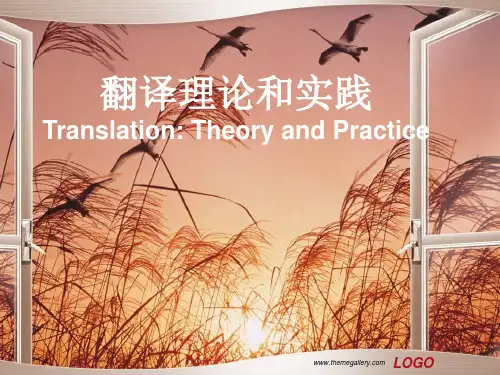
![翻译理论与实践[汉译英]3.2语境与词汇的翻译](https://uimg.taocdn.com/c6bd6d7ac281e53a5902ff51.webp)


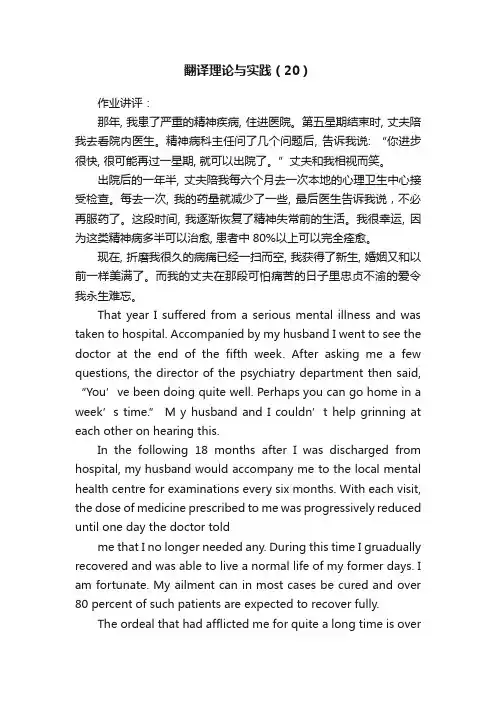
翻译理论与实践(20) 作业讲评: 那年, 我患了严重的精神疾病, 住进医院。第五星期结束时, 丈夫陪我去看院内医生。精神病科主任问了几个问题后, 告诉我说: “你进步很快, 很可能再过一星期, 就可以出院了。”丈夫和我相视而笑。 出院后的一年半, 丈夫陪我每六个月去一次本地的心理卫生中心接受检查。每去一次, 我的药量就减少了一些, 最后医生告诉我说,不必再服药了。这段时间, 我逐渐恢复了精神失常前的生活。我很幸运, 因为这类精神病多半可以治愈, 患者中80%以上可以完全痊愈。 现在, 折磨我很久的病痛已经一扫而空, 我获得了新生, 婚姻又和以前一样美满了。而我的丈夫在那段可怕痛苦的日子里忠贞不渝的爱令我永生难忘。 That year I suffered from a serious mental illness and was taken to hospital. Accompanied by my husband I went to see the doctor at the end of the fifth week. After asking me a few questions, the director of the psychiatry department then said, “You’ve been doing quite well. Perhaps you can go home in a week’s time.” M y husband and I couldn’t help grinning at each other on hearing this. In the following 18 months after I was discharged from hospital, my husband would accompany me to the local mental health centre for examinations every six months. With each visit, the dose of medicine prescribed to me was progressively reduced until one day the doctor told me that I no longer needed any. During this time I gruadually recovered and was able to live a normal life of my former days. I am fortunate. My ailment can in most cases be cured and over 80 percent of such patients are expected to recover fully. The ordeal that had afflicted me for quite a long time is over now. I feel like I’ve been given a new life and my family life is now as happy as ever before. I shall never forget the constant love my husband showed me all through this distressing period. Disease, illness of people, animals, plants, etc., caused by infection or a failure of health rather than by an accident: a contagious/infectious disease a common/rare/incurable/fatal disease They reported a sudden outbreak of the disease in the south of the country. The first symptom of the disease is a very high temperature. She has caught/contracted(= begun to have)a lung disease/disease of the lungs. Starvation and disease have killed thousands of refugees. Illness, ill, adjective not feeling well, or suffering from a disease: I felt ill so I went home. He's been ill with meningitis. Sophia fell ill/was taken ill (= became ill) while on holiday. He is critically(= very badly) ill in hospital. Illness noun 1 a disease of the body or mind: He died at home after a long illness. Sickness, sick (ILL) adjective physically or mentally ill; not well or healthy: a sick child a sick cow My father has been off sick (= not working because of illness) for a long time. Anyone who could hurt a child like that must be sick (= mentally ill). The old woman fell/took/was taken sick (= became ill)while she was away and had to come home. Sarah called in/reported sick (= told her employer that she was unable to go to work because of illness). FIGURATIVE High rates of crime are considered by some people to be a sign of a sick society. See also heartsick; homesick; lovesick, bussick, seasick, airsick Ailment, an illness: Treat minor ailments yourself. Malady, noun [C] FORMAL 1 a disease: All the rose bushes seem to be suffering from the same mysterious malady. 2 a problem within a system or organization: Apathy is one of the maladies of modern society. Physical disorder, indisposition Conversion of perspectives Translation is based on the assumption that the c that the content of human thinking is basically the same, but the congnitive angles or thinking modes may not necessarily be the same. At times people from different cultures approach the same thing from different perspectives. These differences are reflected in their respective languages and often pose barriers for inter-cultural communication. To ensure smooth communication between cultures, it is necessary to shift the perspectives in translation. 1.She set a good table. 她摆了一桌丰盛的菜肴。 2.He beat her black and blue. 他把她打得青一块,紫一块。 3.People began to leave the hall by ones and twos. 人们开始三三两两 地离开大厅。 4.Students get a discount of 20% on air fares. 学生买机票可打八折。 5.Hardbacks are usually more expensive than paperbacks. 精装书通常 比简装书贵。 6.I can read her thoughts. 我能看出她的心思。 7.Parent s’ love of their children is perfect and minute. 父母爱子女无微 不至。 8.What kind of sailor are you? 你晕不晕船? 9.For 20 years we were passive witnesses to the deterioration of prices of our raw materials and an excessive increase of the prices of manufactured goods. 我们在20年内坐视原料价格下跌和工业品价格暴涨。 10.T he mastery of language is not easy and requires painstaking effort. 语言这东西不是随便可以学好的,非下苦工不可。 11.H e survived the trouble. 他闯过了难关。 12.V ery few of these old coins survived. 这些古钱币现在已经十分罕 见。 13.g reenhouse 温室 14.b lack tea 红茶 15.c ontact lenses隐形眼镜 14.broad jump跳远 15. stopwatch 秒表 16.s kin-deep 肤浅 17.a self-taught musician 自学成材的音乐家
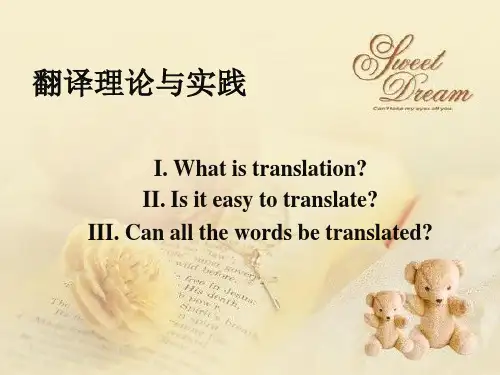
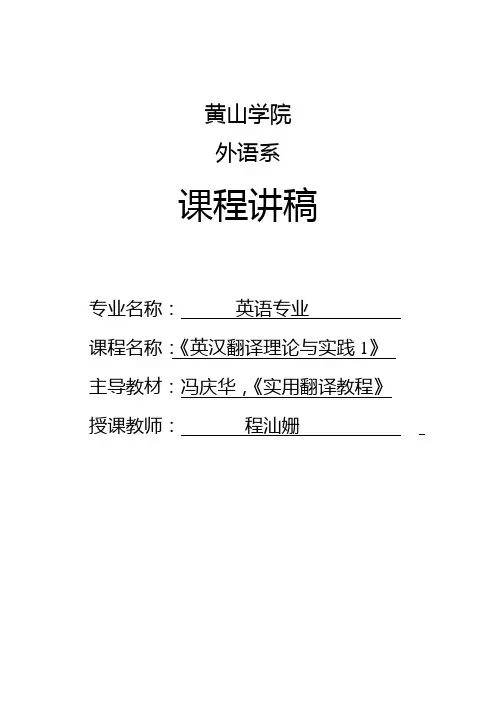
黄山学院外语系课程讲稿专业名称:英语专业课程名称:《英汉翻译理论与实践1》主导教材:冯庆华,《实用翻译教程》授课教师:***A Brief Introduction to Translation◇Teaching Contents:I.Discussion:●What is translation?●What is a successful translation?●What difficulties might occur in translating process?A.What is translation?1.Key words:source language(SL) / receptor language / target language(TL); reproduce; message /information; equivalence / correspondence2.Nature of translationTranslation consists in reproducing in the receptor language the closest naturalequivalent of the source language message, first in terms of meaning and secondly interms of style. (Eugene A. Nida)德国译学教授Wolfram Wilss 在The Science of Translation:Problems & Methods一书中说:Translation is not simply a matter of seeking other words withsimilar meaning, but of finding appropriate ways of saying things in another language.Translating is always meaning-based, i.e. it is the transfer of meaning instead of formfrom the source language to the target language.(翻译不只是在另一种语言中寻找意义相似的其他词语,而是寻找表达事物的适当方式。
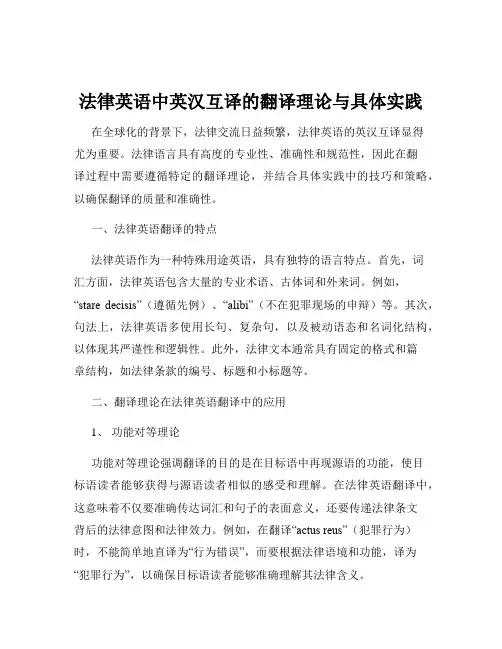
法律英语中英汉互译的翻译理论与具体实践在全球化的背景下,法律交流日益频繁,法律英语的英汉互译显得尤为重要。
法律语言具有高度的专业性、准确性和规范性,因此在翻译过程中需要遵循特定的翻译理论,并结合具体实践中的技巧和策略,以确保翻译的质量和准确性。
一、法律英语翻译的特点法律英语作为一种特殊用途英语,具有独特的语言特点。
首先,词汇方面,法律英语包含大量的专业术语、古体词和外来词。
例如,“stare decisis”(遵循先例)、“alibi”(不在犯罪现场的申辩)等。
其次,句法上,法律英语多使用长句、复杂句,以及被动语态和名词化结构,以体现其严谨性和逻辑性。
此外,法律文本通常具有固定的格式和篇章结构,如法律条款的编号、标题和小标题等。
二、翻译理论在法律英语翻译中的应用1、功能对等理论功能对等理论强调翻译的目的是在目标语中再现源语的功能,使目标语读者能够获得与源语读者相似的感受和理解。
在法律英语翻译中,这意味着不仅要准确传达词汇和句子的表面意义,还要传递法律条文背后的法律意图和法律效力。
例如,在翻译“actus reus”(犯罪行为)时,不能简单地直译为“行为错误”,而要根据法律语境和功能,译为“犯罪行为”,以确保目标语读者能够准确理解其法律含义。
2、目的论目的论认为翻译是一种有目的的行为,翻译的目的决定了翻译的策略和方法。
在法律英语翻译中,翻译的目的通常是为了使目标语读者能够准确理解法律条文,遵循法律规定。
因此,译者可以根据具体的翻译目的,对源语文本进行适当的调整和改写。
比如,为了使译文更符合目标语的法律体系和法律文化,可以对一些法律概念进行解释和说明。
三、法律英语英汉互译的具体实践技巧1、专业术语的翻译准确翻译专业术语是法律英语翻译的关键。
对于常见的专业术语,可以通过查阅专业词典、法律文献和相关资料来确定其准确的译名。
对于一些新出现的或特定领域的术语,可以采用直译、意译、音译或加注的方法进行翻译。
例如,“intellectual property”直译为“知识产权”,“due diligence”意译为“尽职调查”,“patent”音译为“专利”,对于一些复杂的术语,如“mortgagebacked security”(抵押支持证券),可以在翻译后加注进行解释。
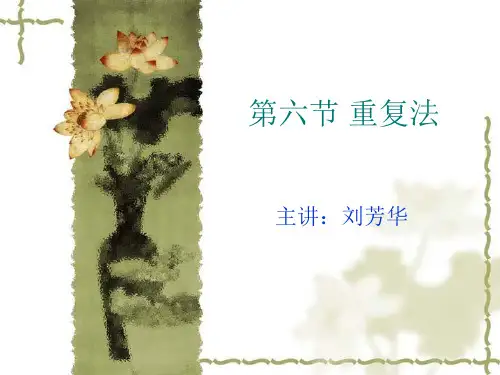
黄山学院外语系课程讲稿专业名称:英语专业课程名称:《英汉翻译理论与实践1》主导教材:冯庆华,《实用翻译教程》授课教师:程汕姗A Brief Introduction to Translation◇Teaching Contents:I.Discussion:●What is translation?●What is a successful translation?●What difficulties might occur in translating process?A.What is translation?1.Key words:source language(SL) / receptor language / target language(TL); reproduce; message /information; equivalence / correspondence2.Nature of translationTranslation consists in reproducing in the receptor language the closest naturalequivalent of the source language message, first in terms of meaning and secondly interms of style. (Eugene A. Nida)德国译学教授Wolfram Wilss 在The Science of Translation:Problems & Methods一书中说:Translation is not simply a matter of seeking other words withsimilar meaning, but of finding appropriate ways of saying things in another language.Translating is always meaning-based, i.e. it is the transfer of meaning instead of formfrom the source language to the target language.(翻译不只是在另一种语言中寻找意义相似的其他词语,而是寻找表达事物的适当方式。
翻译始终立足于语义,也就是说,是语义从源语到译语的转换,而不是形式。
)这说明了翻译是语义的翻译,不是语言形式的翻译,是运用另一种语言的适当方式来表达一种语言所表达的内容,而不是在另一种语言中寻找与一种语言中含义相似的某些词语或结构。
翻译必须跳出原文语言层面的束缚,必须着眼于传达原文的内容和意义。
换句话说,翻译的基本单位应该是语篇,而不是词语结构。
根据系统功能语言学家的观点,语言的实际使用单位是语篇这样的言语单位,而不是词语结构这样的语法单位。
实际使用的语篇有可能是一个句子、一个句段、一个句群,也有可能是一个词语。
翻译作为语言交际的一种形式,其实质是用一种语言的语篇材料代替另一种语言与其意义对等的语篇材料。
翻译是运用一种语言把另一种语言所表达的内容和意义准确而完整地重新表达出来的语言活动。
3.Classification of translation:a.Oral interpretation / written translationb.Human translation / machine translationc.Literary / scientific / political / commercial translationd.Domestication (naturalization) / foreignization (estrangement, alienation)e.Literal translation / free translationB.What is a successful translation?1.严复:信、达、雅(faithfulness, expressiveness, elegance)2.傅雷:以效果而论,翻译应当象临画一样,所求的不在形似而在神似3.钱钟书:诱、讹、化4.Eugene A. Nida: natural / close; dynamic/functional equivalenceC.What difficulties might occur in translating process?Language / Cultural BarriersTranslatability is lower when (1) the work to be translated is quite distant both intime and space; (2) its form is very much unique; (3) the content is not shared in thetwo cultures.→Betrayal: Loss / Distortion1.Understandingi.Word meaningExample analysisMillet made a portrait of Lady Chesterfield, which flattered her.米勒为了逢迎柴斯特菲尔德夫人而替她画了一幅像。
(原文中的flatter 意为“超过”[to make better looking than the reality] ,将其译为“逢迎”是理解上的错误。
)米勒给柴斯特菲尔德夫人画了一幅像,该像之美简直超过了她本人。
ii.Sentence structureExample analysisThe traditionalist type of composer begins with a pattern rather than with atheme. The creative act with Palestrina is not the thematic conception so muchas the personal treatment of a well-established pattern.【原译】传统主义型作曲家始于某种格调而非某种主题。
帕莱斯特里纳的创作行为不太像对固定格调进行个性化处理的主题概念。
【改译】传统型作曲家是从形式出发而不是从主题出发进行创作的。
帕莱斯特里纳的创作不是主题的构思,而是对固定形式的个性化处理。
iii.Background knowledgeExample analysisThen he was off to Columbia Business School , where he found his Rosetta Stoneof investing. (Roger Lowenstein: An Unassuming Billionaire )Rosetta Stone 是古埃及石,意为“提供线索”,这儿喻指“帮助了解难题的事物”。
后来他进了哥伦比亚商学院,在那里找到了自己的投资指南。
2.Expressingi.Literal translation Vs. liberal translationLiteral translation takes sentences as its basic units and the whole text intoconsideration at the same time in the course of translation. It strives to reproduceboth the ideological content and the style of the entire literary work and retain asmuch as possible the figures of speech.Liberal Translation mainly convey the meaning and spirit of the originalwithout trying to reproduce its sentence pattern or figures of speech.Example analysisTo kill two birds with one stone.直译:一石二鸟意译:一箭双雕,一举两得树倒猢狲散直译:When the tree falls, the monkeys scatter.意译:Members run away when the family falls. / Rats leave asinking ship.ii.Free translationExample analysisThis was one of the secrets of his great popularity, but it was a popularity whichwas as unsettled as the waves. It swelled, and bubbled, and foamed for a while,only to recede, and be lost to its former possessor.【原译】这是他名噪一时的一个秘密,但这种名声如同波涛一样起伏不定:在短暂的时间内如日中天,盛极一时,炙手可热,但转瞬间又烟消云散,终于在原来有些声望的人身上消失了。
【改译】这是他名噪一时的一个秘密,但这种名声如同波涛一样起伏不定:一时间奔腾高涨,汹涌澎拜,转瞬间又一落千丈,终于在原来享有这种声望的人身上荡然无存。
iii.TranslationeseExample analysisThe only concession he made to the climate was to wear a white dinner jacket.【原译】他对气候的唯一让步就是穿了一件白色的短餐衣。
【改译】气候变化,他仅稍稍作了一点变通,赴宴时穿了件白色的短礼服。
iv.Cohesion and coherenceExample analysisThere was a menu , but it didn’t make any difference , everything tasted the same.Monumental portion. You’d stand up at the end and want to die.(M. Lurie , A Beacon in the Night)【原译】那儿有菜单,可没什么区别。